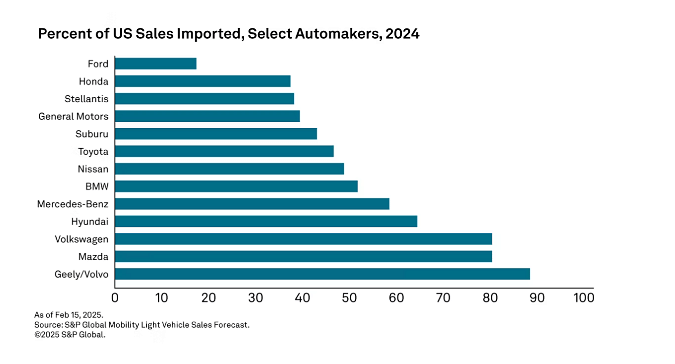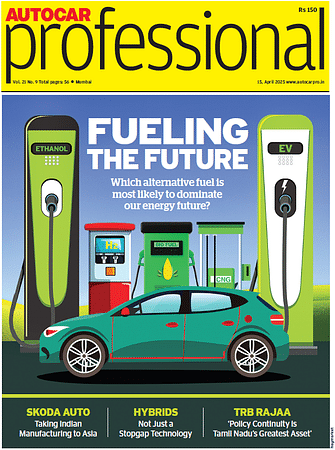Tariffs at Full Throttle: 45% of U.S. Auto Sales Now in the Crosshairs - says S&P Global
How Trump’s trade blitz threatens to upend the auto industry’s global engine.
President Trump’s sweeping new tariff regime is set to disrupt nearly half of all light-duty vehicle sales in the United States, triggering a potential reshaping of the country’s automotive supply chain and pricing landscape.
“US auto tariffs could impact as much as 45% of light-duty vehicles sold in the US,” says Stephanie Brinley, Associate Director of AutoIntelligence at S&P Global Mobility. Of this, “about 23% of that 45% were imported from outside of North America,” underscoring the deep reliance on global sourcing.
The Quantum of Impact
In 2024, the U.S. market sold approximately 16 million light-duty vehicles. Based on current import volumes, around 7.2 million vehicles are at risk of being affected by the tariffs. Roughly 3.7 million of these are imported from countries outside of North America—such as Japan, South Korea, and Germany—making them especially vulnerable to the new 25% tariff imposed under Section 232.
The remaining 3.5 million units—those from Canada and Mexico—aren’t safe either. They remain under the 25% IEEPA-based tariff and will eventually face a 12% reciprocal tariff once those orders expire.
Even automakers with domestic operations are feeling the pinch. Brinley explains that “the tariff rate remains 25%, but... the value the tariff would be applied to would be the cost of the vehicle minus the $5,000 value of U.S. content,” showing how even partially American-made vehicles may not escape cost pressures.
What’s Driving the Numbers?

Several key factors contribute to the scale of impact:
Scope of Imports: Nearly half of the U.S. auto market is fueled by imports. With “South Korea being the largest exporter to the US behind Mexico,” Brinley says, the impact hits not just foreign automakers but U.S.-based companies like General Motors, which import vehicles or parts from Korea.
Tariff Stacking Avoided—But Still Steep: Initial concerns that the reciprocal tariffs would be added on top of the 25% auto tariffs have been set aside. Brinley clarifies: “While there was concern... this is not the case.” However, many countries will still face reciprocal tariffs as high as 20%, bringing total duties close to or matching 25%.
Auto Parts and Raw Materials: The 25% tariff isn’t limited to finished vehicles. Section 232 tariffs also apply to parts, steel, and aluminum—raising costs across the board, even for vehicles assembled in the U.S. This is especially problematic for automakers dependent on global parts flows.
Commercial Vehicle Sector: The medium- and heavy-duty commercial vehicle (MHCV) segment is also vulnerable. Brinley notes: “The MHCV sector... will not emerge unscathed.” Orders for Class 8 trucks are already “one-third short” of earlier projections.
Market Forecast: Volume Down, Prices Up
S&P Global Mobility now forecasts that U.S. light vehicle sales could drop to between 14.5 and 15 million units annually, down from 16 million in 2024. That decline, largely driven by higher prices and supply chain uncertainty, could erase hundreds of thousands of sales per year.
Tariffs on parts and raw materials are also likely to push production costs higher. For example, the 25% tariff on steel and aluminum remains in place, adding pressure to vehicle frames, bodies, and critical components.
“These tariffs are expected to increase costs in the short term,” Brinley confirms, warning that efforts to shift manufacturing to the U.S. will be costly and slow.
A Shifting Global Trade Environment

While some nations like Canada and Mexico are temporarily exempt from the new reciprocal tariffs, “once Canada and Mexico are free of the IEEPA-based 25% tariff, a 12% tariff will be imposed under the reciprocal tariff order,” says Brinley.
In parallel, countries that retaliate against the U.S. may face even steeper rates. The administration’s tariff authority allows for rapid escalation: “The President can increase the tariff if a country retaliates or reduce it if the country takes other actions to reduce its tariff or non-tariff barriers on US goods.”
A Costly Transformation
While the White House views these tariffs as a national security and economic protection measure, industry experts see them as a disruptive force. Brinley sums it up: “There is no quick solution, and increasing manufacturing in the US, particularly based on an artificial economic condition, will be costly and is likely to create a more expensive manufacturing environment.”
With nearly half of U.S. vehicle sales exposed, billions of dollars in imports affected, and automakers caught between policy and profit margins, the Trump tariffs are not just a trade strategy—they’re an economic shockwave.
RELATED ARTICLES
Apollo Tyres To Cease Production At Enschede Plant Amid Rising Costs And Market Shifts
Indian manufacturer plans to wind down the Netherlands operations by summer 2026.
Ather Energy Raises Rs 1,340 Crore from Anchor Investors ahead of IPO
SBI Mutual Fund schemes picked up around 23.1% of the total shares purchased by anchor investors, while Aditya Birla Sun...
Maruti Suzuki to Equip All Cars with Six Airbags This Year, Says Chairman Bhargava
"From a safety point of view, the government was very keen that six airbags should be in all cars. We will implement thi...






 05 Apr 2025
05 Apr 2025
 2036 Views
2036 Views





 Shahkar Abidi
Shahkar Abidi


 Shruti Shiraguppi
Shruti Shiraguppi

 Prerna Lidhoo
Prerna Lidhoo

